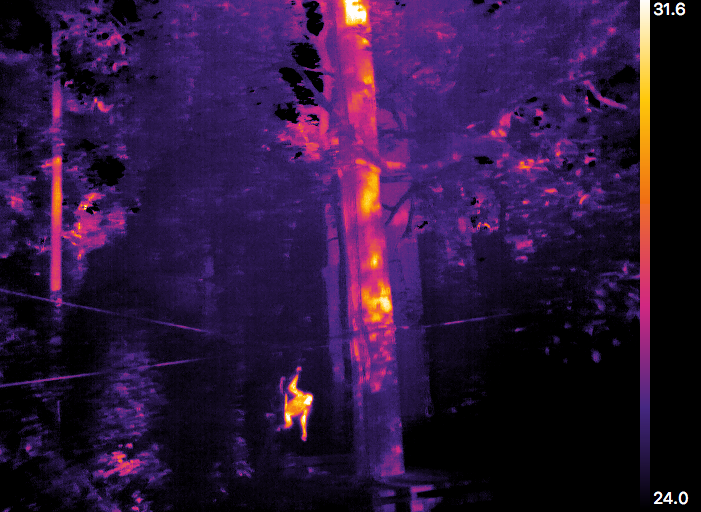Astro-ecology: Counting orangutans using star-spotting technology
A collaboration between astrophysicists, conservationists and ecologists aims to save rare and endangered animals.
A ground-breaking scientific collaboration is harnessing technology used to study the luminosity of stars, to carry out detailed monitoring of orangutan populations in Borneo.
Liverpool John Moores University, WWF and HUTAN came together to examine better ways of detecting the great apes in the Bornean forest canopy, by using drones fitted with thermal-imaging cameras.

Orangutans, like all great apes, build a sleeping nest in trees. Traditionally orangutan numbers are estimated by counting these nests from the ground. However, this method is costly and time consuming due to the large areas that need to be surveyed.
Drones can cover large areas of difficult ground quickly and monitor endangered wildlife from above. The addition of thermal-imaging cameras has even more benefits, as a new study shows: They can detect difficult to find animals at any time of day or night because of their heat signatures. The field team conducted 28 flights at two sites over six days and successfully spotted 41 orangutans from the air, all of which were confirmed by ground observers.
“All orangutan species are critically endangered and monitoring their numbers is crucial for their conservation”, said Professor Serge Wich, Liverpool John Moores University’s expert in primate behavioural ecology.
By combining drone technology with thermal-imaging cameras, which are usually used by astronomers, researchers were able to spot and classify the animals’ heat signatures. To distinguish the primates from their surroundings, they performed flights before 9 a.m. or after 7 p.m. local time.
Dr Claire Burke, an astro-ecologist at the university, who will present the findings at the ‘Unifying Tropical Ecology’ conference in Edinburgh today said:
“We tested the technology on orangutans in the dense tropical rainforest of Sabah in Malaysia. In thermal images, animals shine in a similar way to stars and galaxies, so we used techniques from astronomy to detect and distinguish them.”
Dr Burke added:
“We were not sure at all whether this would work, but with the thermal-infrared camera we could see the orangutans quite clearly because of their body heat, even during fog or at night.”
“The biggest difficulties occur when the temperature of the ground is very similar to that of the animal we are trying to detect, so the images from morning or evening flights are more reliable. Absolute surface temperatures cannot be used to differentiate species as animal body temperatures change with that of their environment.”
This innovative technology could potentially be used to understand and monitor population numbers of orangutans or other endangered primate species.
Nicola Loweth, Asian Programme Manager at WWF, who was on the Bornean study said:
“As ever more species are decimated, due to human activity such as deforestation, we must embrace and scale up innovative approaches to monitoring wildlife populations, to better protect them for generations to come.
Our collaboration with Liverpool John Moores University to test the feasibility of thermal-imaging and drone technology to monitor orangutan populations in Sabah has proven promising and could have a wide range of applications, benefiting wildlife conservation as a whole.”
The team also spotted a troop of proboscis monkeys during the field trial, which they were able to distinguish from orangutans based on their smaller size. Besides that, proboscis monkeys are generally found in groups, whereas orangutans tend to be solitary or in pairs. Pygmy elephants were also captured on a night-time forage through an oil palm plantation.
The astro-ecologists are now developing a machine learning algorithm to tell animal species apart, based on their unique thermal fingerprint.
“In the future, we hope to be able to track, distinguish and monitor large numbers of different species of animals in real time, all around the globe, so that this technology can be used to make a real impact on conservation and stop poaching before it happens”, Dr Burke concluded.
The group previously tested the technology with spider monkeys in Mexico and riverine rabbits in South Africa and will soon be embarking on a field study with the Lac Alaotra bamboo lemurs in Madagascar.
This research is funded in part by the UK’s Science and Technology Facilities Council (part of UK Research and Innovation), WWF-UK and Global Challenges Research Fund grant ST/R002673/1 (PIs S. Longmore & S. Wich).
The project will feature in the BBC Two ‘Equator from the Air’ series in Spring 2019.
The ‘Unifying Tropical Ecology’ conference in Edinburgh is organised by the British Ecological Society and Society for Tropical Ecology (gtö). There will be an entire session on the use of drones for animal and plant monitoring, including a presentation of the ‘Orangutan Nest Watch’ project where citizen scientists can help researchers look through images to spot orangutans and fig trees.
Media contact:
Sabrina Weiss, Press Officer, British Ecological Society, Email: press@britishecologicalsociety.org, Tel: +44 207 685 2523
Like what we stand for?
Support our mission and help develop the next generation of ecologists by donating to the British Ecological Society.